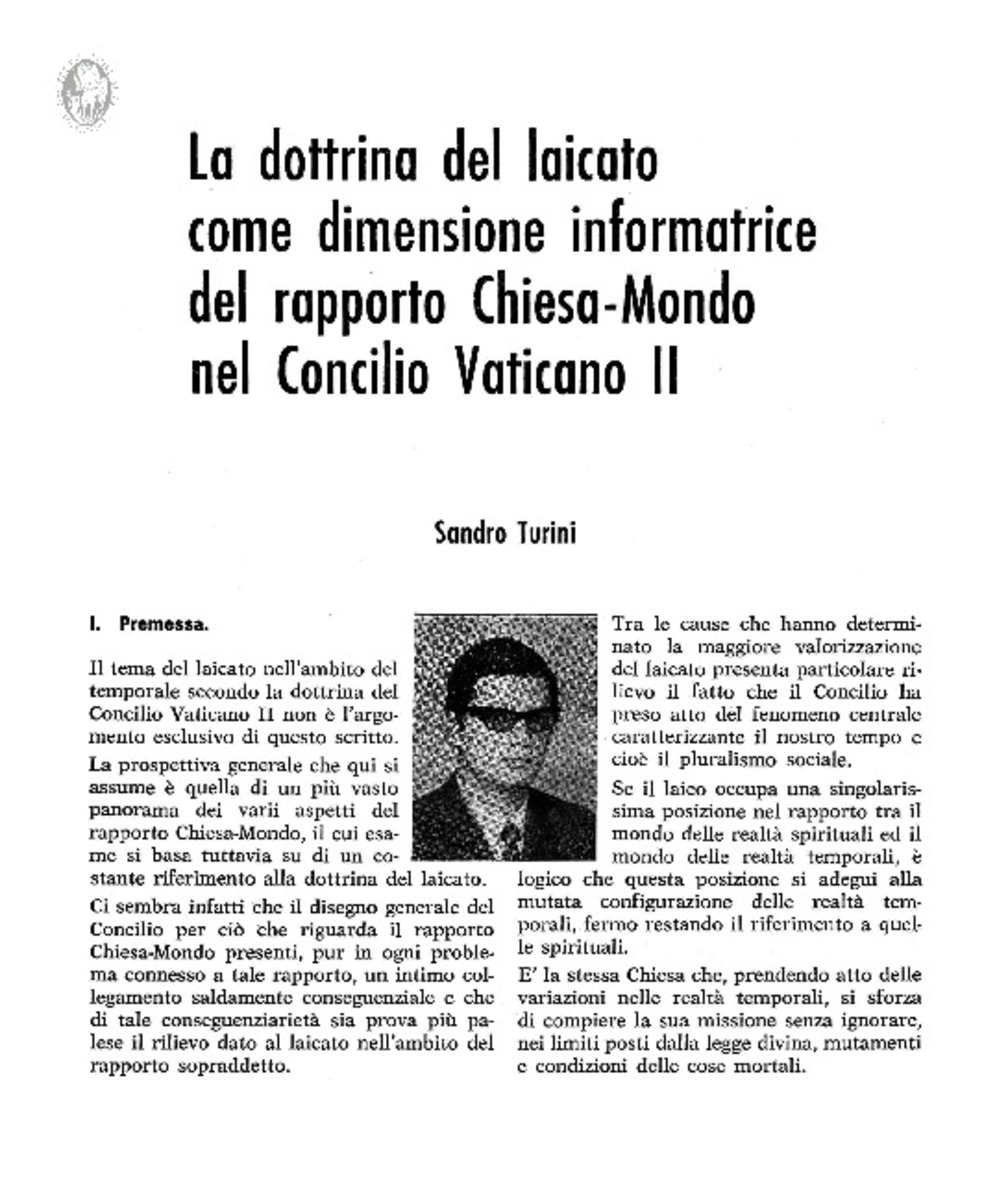Full metadata record
| DC Field | Value | Language |
|---|---|---|
| dc.creator | Turini, S. (Sandro) | |
| dc.date.accessioned | 2010-12-15T11:55:54Z | - |
| dc.date.available | 2010-12-15T11:55:54Z | - |
| dc.date.issued | 1972 | - |
| dc.identifier.citation | IUS CANONICUM, XII, N.II, 1972, pág. 57-85 | es_ES |
| dc.identifier.issn | 0021-325X | - |
| dc.identifier.uri | https://hdl.handle.net/10171/14630 | - |
| dc.description.abstract | SUMMARIUM Hoc studium de doctrina laicorum oppetit quaestionem relationum Ecclesiae et mundi lumini praeceptorum Conci1ii, sumens nucleum investigationis doctrinam laicorum in rebus saeculi. Fundamentale pondus humanae personae laicique ut talis, praeter fidelem, in Concilio Vaticano Il hunc proprium prospectum exigit. In primis paragraphum IIl, «De laicis et de personae humanae dignitate», agit de mutua conexione atque intelligentia duorum thematum etsi se contineat problematibus libertatis religiosae. Thema autem personae humanae,. media Concilii declaratio, in hoc paragrapho non examinatur quamquam adsit rector totius operis valde nexum cum themate laicorum. Alterum est elementum singulare quamvis summa investigatione situm, repraesentatum re pluralismi (socialis religiosique) in quo auctor vult ostendere momentum vi Ecclesiae in mundo profectionis magis quam adventus tantum cogitationis Ecclesiae; et eminent aliquae ulteriores conexiones thematum humanae personae, laicorum et pluralismi, quorum maiores derivationes disseruntur in paragraphis IV et V, de Statu Internationalique communitate; restructuratio primi et magna evolutionis potentia secundi summum exitus sunt plurallsmi et activitatis hominum eam animantium. Eminet in primis in paragrapho IV peculiaris activitas laicorum ordine internationali et munus «creativum» quod in tale contextu possit habere haec activitas, ad Ecclesiam ducem malentem loqui hominibus quam nationibus. Hoc sensu (par. IV) interpretat auctor viam individualem ut primariam ET secundariam institutionalem. Ceterum restructurationi Status explicationes et indications quaerunt, inter eas rationem agendi Concilli in confesionalitatis Stati themate. Denique parag. VI conatur evidentia facere problemata et consequtiones laicorum in rebus saeculi, his conexis cum supra dictis ut coordinentur. Opus experitur facere continuationem conceptuum quae in miscendis et concatenandis thematibus singularibus permittat eminere profundam signüicationem relationum praesentium Ecclesiae et mundi in omnibus suis implicationibus valde praecipuis. ----------------------------------ABSTRACT This present work on the laity deals with the question of Church-World relationship in the light of Conciliar teaching, taking as the medium of investigation, the doctrine concerning the laity in temporal affairs. This particular perspective is derived from the fundamental significance given to the human person and to the layman as such, and not as a member of the faithful, in the II Vatican Council. Paragraph 3, «the layman and the dignity of the human person», in particular, is dedicated to the co-relation of these two subjects and the aspects of compenetration which they offer, though often limited to the problems of religious freedom. The subject of the human person,. which occupies a central position in the Conciliar presentation, is not in fact exhausted nor could it be, in such a paragraph: it is present throughout the whole of this work as a connecting thread linked with that of laity. Another basic element, overlooking and influencing this investigation, is that represented by the phenomenon of «pluralism» (social and religious) considered (par. 2) not so much as the terminal point of the Church's meditation, but as the point of departure for the activity of the Church in the world. A series of further co-relations between the subjects of the human person, the layman and pluralism are singled out, whose major consequences cannot be felt elsewhere than in the subjects dealt with in paragraphs 4 and 5, 1. e. the State and the international Community. For, the new dimension which has been given to the former and the richness of the evolutive protentiality of the latter are no more than the result of pluralism and the activity of the human beings which animate it. Paragraph 5, in particular, represents an effort to lay hold up the peculiar characteristics of the action of the laity at an international level and the «creative » function which this activity could have in this context, in accordance with the guidance of the Church, which chose to speak first to the world of men and afterwards to the Nations. It is in this sense that individual life is considered primary and that of Institutions secondary (par. 4). In addition, further explanations and indications are sought regarding the new dimension given to the Sta te, among which the manner in which the Council dealt with the confessionality of the State, ls included. Finally, in paragraph 6,an effort is made to place in evidence certain problems and consequences of a necessary harmonisation between potestas in temporalibu8 and the function of the laity in temporal affairs, recalling those points previously developed for the co-ordination. Throughout this work an attempt has been made to maintain a conceptual continuity, which, founded in and linked to the individual topics, would favour the emphasis of the profound significance of the actual Church-World relationships in aH its very important implications. | es_ES |
| dc.language.iso | ita | es_ES |
| dc.publisher | Servicio de Publicaciones de la Universidad de Navarra | es_ES |
| dc.rights | info:eu-repo/semantics/openAccess | es_ES |
| dc.subject | Concilio Vaticano II | es_ES |
| dc.subject | Laicismo | es_ES |
| dc.subject | Iglesia católica | es_ES |
| dc.subject | Estado | es_ES |
| dc.subject | Materias Investigacion::Derecho canónico | es_ES |
| dc.title | La dottrina del laicato come dimensione informatrice del rapporto Chiesa-Mondo nel Concilio Vaticano II | es_ES |
| dc.type | info:eu-repo/semantics/article | es_ES |
| dc.identifier.doi | 10.15581/016.12.21375 | es_ES |
Files in This Item:
Statistics and impact
Items in Dadun are protected by copyright, with all rights reserved, unless otherwise indicated.






